Luxury fashion conglomerate Tapestry (NYSE:TPR) fell short of analysts' expectations in Q1 CY2024, with revenue down 1.8% year on year to $1.48 billion. The company's full-year revenue guidance of $6.6 billion at the midpoint also came in 2% below analysts' estimates. It made a GAAP profit of $0.60 per share, down from its profit of $0.78 per share in the same quarter last year.
Tapestry (TPR) Q1 CY2024 Highlights:
- Revenue: $1.48 billion vs analyst estimates of $1.50 billion (1.1% miss)
- EPS: $0.60 vs analyst expectations of $0.63 (5.2% miss)
- The company dropped its revenue guidance for the full year from $6.7 billion to $6.6 billion at the midpoint, a 1.5% decrease
- Gross Margin (GAAP): 74.7%, up from 72.8% in the same quarter last year
- Free Cash Flow of $78.8 million, down 90.2% from the previous quarter
- Market Capitalization: $8.94 billion
Originally founded as Coach, Tapestry (NYSE:TPR) is an American fashion conglomerate with a portfolio of luxury brands offering high-quality accessories and fashion products.
Coach, the cornerstone brand of the company that was founded in 1941, became a leader in the luxury leather goods market, offering iconic high-quality handbags. With an expanding vision, the company evolved to encompass other notable brands in the luxury market such as Kate Spade New York and Stuart Weitzman.
In 2017, Coach rebranded to Tapestry to better mirror its multi-brand identity. The company allows each brand to retain its uniqueness while leveraging Tapestry's vast resources, creating synergies.
Tapestry grew its portfolio once again in 2023 when it agreed to buy Capri Holdings. The acquisition gave it ownership of Versace, Jimmy Choo, and Michael Kors. These brands also appeal to fashion-savvy and brand-conscious luxury-centric customers with a preference for premium clothing and accessories.
Apparel, Accessories and Luxury Goods
Within apparel and accessories, not only do styles change more frequently today than decades past as fads travel through social media and the internet but consumers are also shifting the way they buy their goods, favoring omnichannel and e-commerce experiences. Some apparel, accessories, and luxury goods companies have made concerted efforts to adapt while those who are slower to move may fall behind.
Tapestry’s main competitors are PVH Corp (NYSE:PVH) who owns Calvin Klein and Tommy Hilfiger; Kering (OTCMKTS:PPRUY) who owns Gucci, Yves Saint Laurent, and Bottega Veneta; LVMH Moët Hennessy Louis Vuitton (OTCMKTS:LVMUY) who owns Louis Vuitton, Dior, Givenchy; Ralph Lauren (NYSE:RL)Sales Growth
Examining a company's long-term performance can provide clues about its business quality. Any business can put up a good quarter or two, but the best consistently grow over the long haul. Tapestry's annualized revenue growth rate of 2.2% over the last five years was weak for a consumer discretionary business. 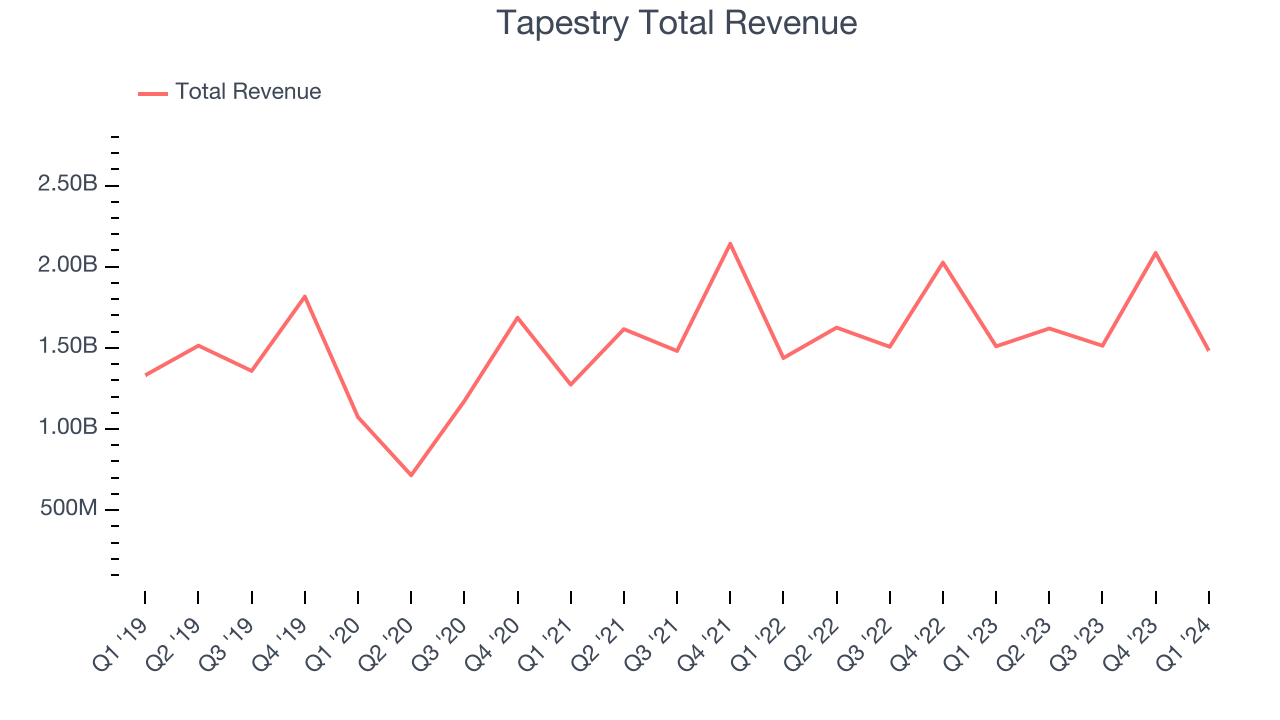 Within consumer discretionary, a long-term historical view may miss a company riding a successful new product or emerging trend. That's why we also follow short-term performance. Tapestry's recent history shines a dimmer light on the company as its revenue was flat over the last two years.
Within consumer discretionary, a long-term historical view may miss a company riding a successful new product or emerging trend. That's why we also follow short-term performance. Tapestry's recent history shines a dimmer light on the company as its revenue was flat over the last two years.
Tapestry also reports sales performance excluding currency movements, which are outside the company’s control and not indicative of demand. Over the last two years, its constant currency sales averaged 2.6% year-on-year growth. Because this number is higher than its revenue growth during the same period, we can see that foreign exchange rates have been a headwind for Tapestry. 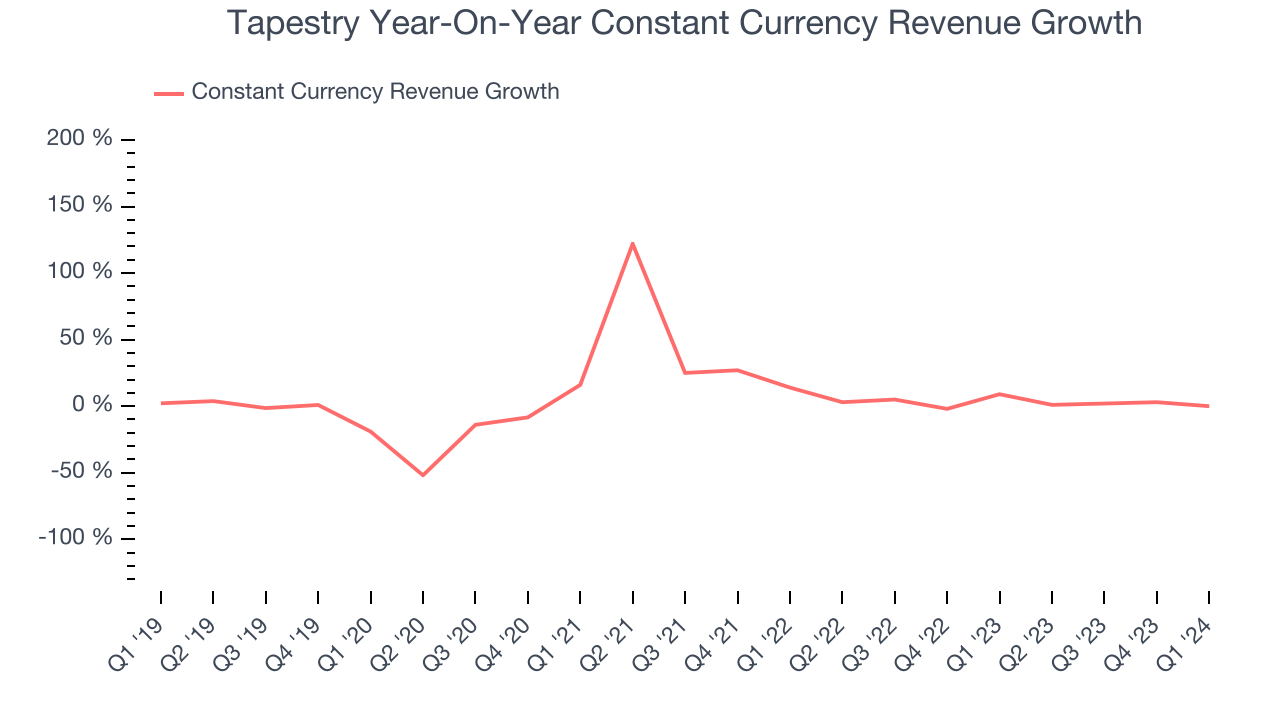
This quarter, Tapestry missed Wall Street's estimates and reported a rather uninspiring 1.8% year-on-year revenue decline, generating $1.48 billion of revenue. Looking ahead, Wall Street expects sales to grow 3.1% over the next 12 months, an acceleration from this quarter.
Operating Margin
Operating margin is a key measure of profitability. Think of it as net income–the bottom line–excluding the impact of taxes and interest on debt, which are less connected to business fundamentals.
Tapestry has been a well-managed company over the last eight quarters. It's demonstrated it can be one of the more profitable businesses in the consumer discretionary sector, boasting an average operating margin of 17.4%.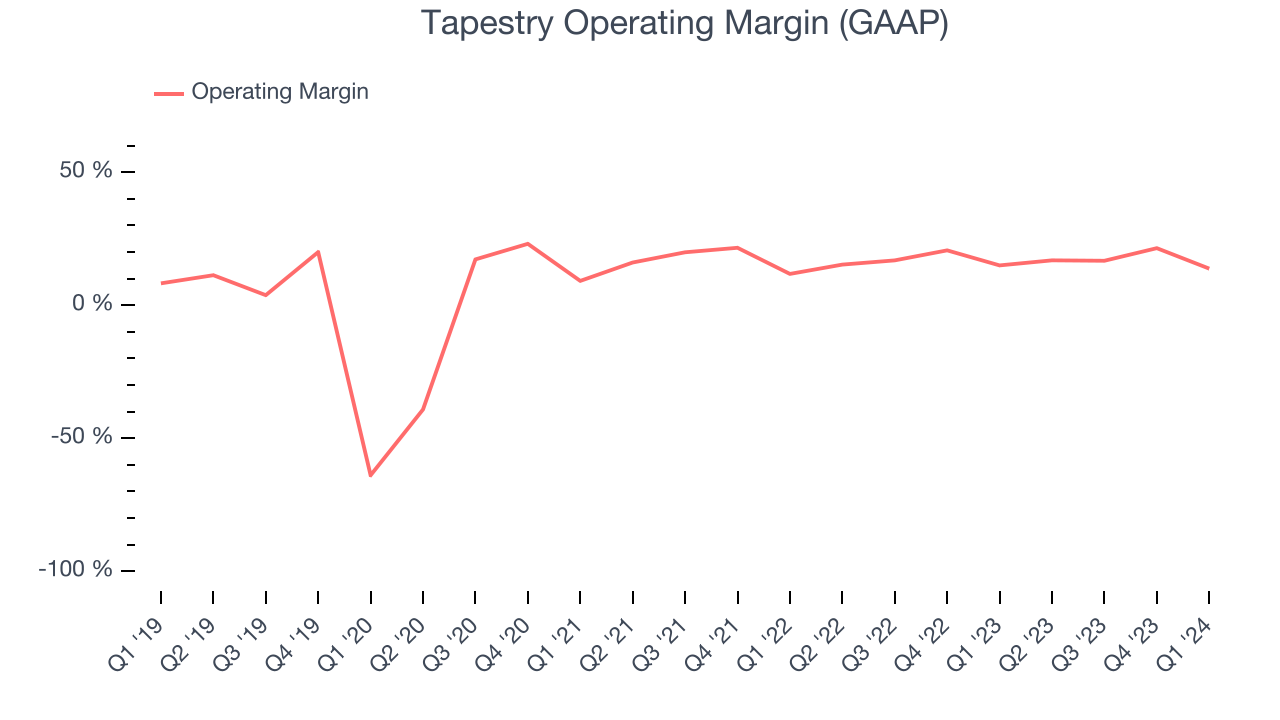
In Q1, Tapestry generated an operating profit margin of 13.8%, down 1.2 percentage points year on year.
Over the next 12 months, Wall Street expects Tapestry to become more profitable. Analysts are expecting the company’s LTM operating margin of 17.6% to rise to 19%.EPS
We track long-term historical earnings per share (EPS) growth for the same reason as long-term revenue growth. Compared to revenue, however, EPS highlights whether a company's growth was profitable. 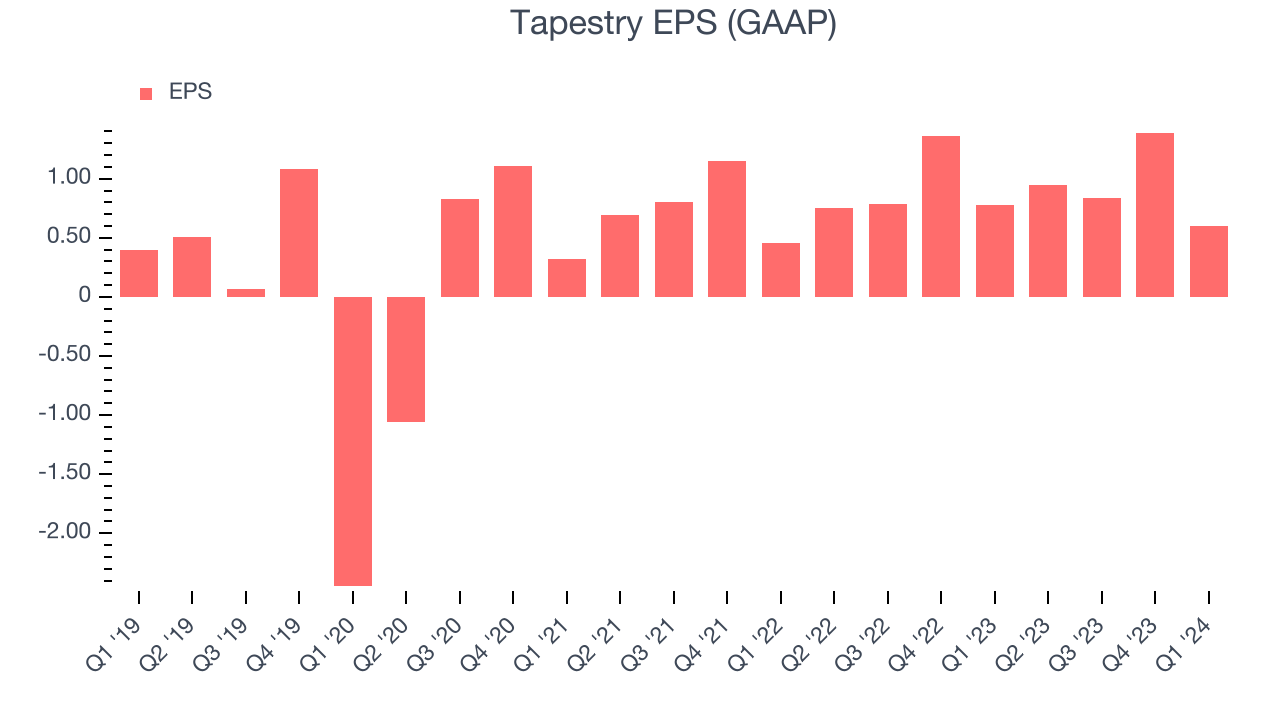
Over the last five years, Tapestry's EPS grew 55.8%, translating into an unimpressive 9.3% compounded annual growth rate. This performance, however, is materially higher than its 2.2% annualized revenue growth over the same period. Let's dig into why.
While we mentioned earlier that Tapestry's operating margin declined this quarter, a five-year view shows its margin has expanded 5.5 percentage points while its share count has shrunk 19.5%. Improving profitability and share buybacks are positive signs as they juice EPS growth relative to revenue growth.In Q1, Tapestry reported EPS at $0.60, down from $0.78 in the same quarter last year. This print unfortunately missed analysts' estimates. Over the next 12 months, Wall Street expects Tapestry to grow its earnings. Analysts are projecting its LTM EPS of $3.78 to climb by 17.2% to $4.43.
Cash Is King
If you've followed StockStory for a while, you know we emphasize free cash flow. Why, you ask? We believe that in the end, cash is king, and you can't use accounting profits to pay the bills.
Over the last two years, Tapestry has shown solid cash profitability, giving it the flexibility to reinvest or return capital to investors. The company's free cash flow margin has averaged 14.6%, above the broader consumer discretionary sector.
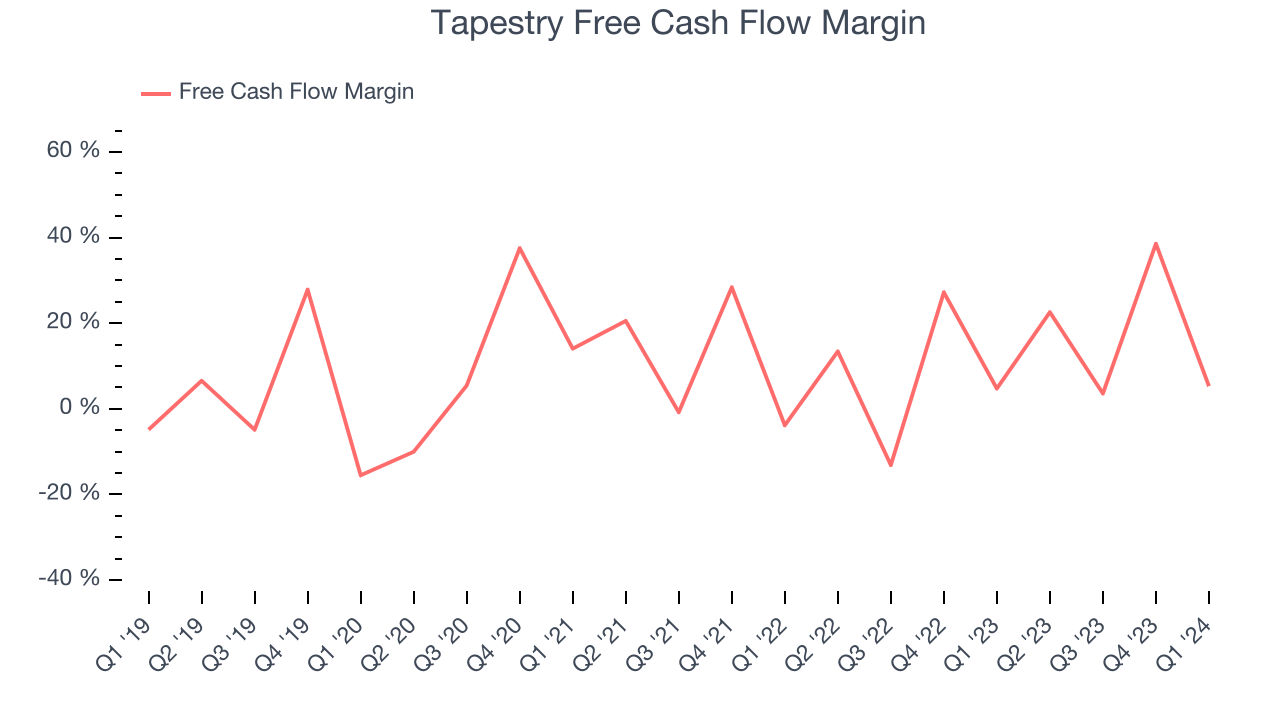
Tapestry's free cash flow came in at $78.8 million in Q1, equivalent to a 5.3% margin and up 10.1% year on year. Over the next year, analysts predict Tapestry's cash profitability will fall. Their consensus estimates imply its LTM free cash flow margin of 19.4% will decrease to 15%.
Return on Invested Capital (ROIC)
EPS and free cash flow tell us whether a company was profitable while growing revenue. But was it capital-efficient? A company’s ROIC explains this by showing how much operating profit a company makes compared to how much money the business raised (debt and equity).
Tapestry's five-year average return on invested capital was 15.3%, slightly better than the broader sector. Just as you’d like your investment dollars to generate returns, Tapestry's invested capital has produced decent profits.
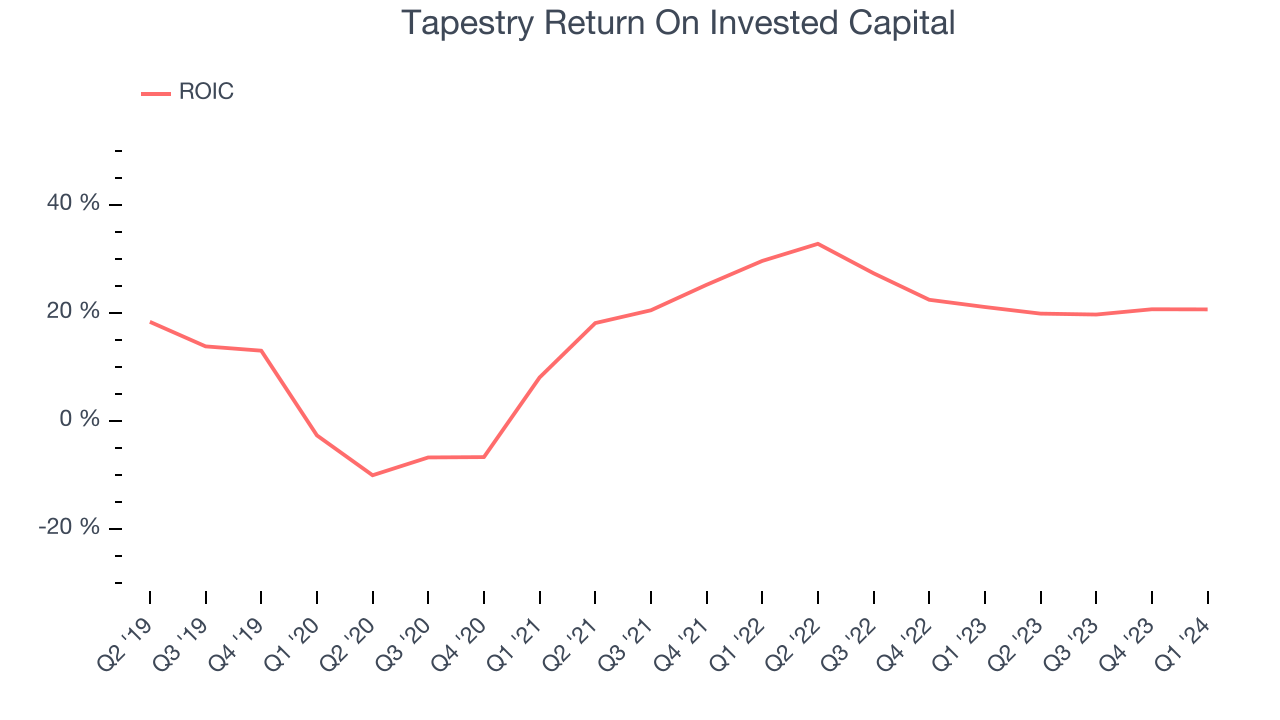
The trend in its ROIC, however, is often what surprises the market and drives the stock price. Over the last few years, Tapestry's ROIC has significantly increased. This is a good sign, and we hope the company can continue improving.
Balance Sheet Risk
As long-term investors, the risk we care most about is the permanent loss of capital. This can happen when a company goes bankrupt or raises money from a disadvantaged position and is separate from short-term stock price volatility, which we are much less bothered by.
Tapestry reported $7.42 billion of cash and $9.27 billion of debt on its balance sheet in the most recent quarter. As investors in high-quality companies, we primarily focus on two things: 1) that a company's debt level isn't too high and 2) that its interest payments are not excessively burdening the business.
With $1.40 billion of EBITDA over the last 12 months, we view Tapestry's 1.3x net-debt-to-EBITDA ratio as safe. We also see its $14.1 million of annual interest expenses as appropriate. The company's profits give it plenty of breathing room, allowing it to continue investing in new initiatives.
Key Takeaways from Tapestry's Q1 Results
It was great to see Tapestry's strong earnings forecast for the full year, which exceeded analysts' expectations. On the other hand, its full-year revenue guidance missed and its EPS fell short of Wall Street's estimates. Overall, this was a mediocre quarter for Tapestry. The company is down 3.9% on the results and currently trades at $37.48 per share.
Is Now The Time?
Tapestry may have had a tough quarter, but investors should also consider its valuation and business qualities when assessing the investment opportunity.
We cheer for all companies serving consumers, but in the case of Tapestry, we'll be cheering from the sidelines. Its revenue growth has been weak over the last five years, but at least growth is expected to increase in the short term. And while its sturdy operating margins show it has disciplined expense controls, unfortunately, its constant currency sales performance has been disappointing.
Tapestry's price-to-earnings ratio based on the next 12 months is 8.8x. While there are some things to like about Tapestry and its valuation is reasonable, we think there are better opportunities elsewhere in the market right now.
Wall Street analysts covering the company had a one-year price target of $50.58 per share right before these results (compared to the current share price of $37.48).
To get the best start with StockStory, check out our most recent stock picks, and then sign up for our earnings alerts by adding companies to your watchlist here. We typically have the quarterly earnings results analyzed within seconds of the data being released, and especially for companies reporting pre-market, this often gives investors the chance to react to the results before the market has fully absorbed the information.
